tow AUDI A5 COUPE 2011 Owner's Manual
[x] Cancel search | Manufacturer: AUDI, Model Year: 2011, Model line: A5 COUPE, Model: AUDI A5 COUPE 2011Pages: 362, PDF Size: 84.88 MB
Page 239 of 362
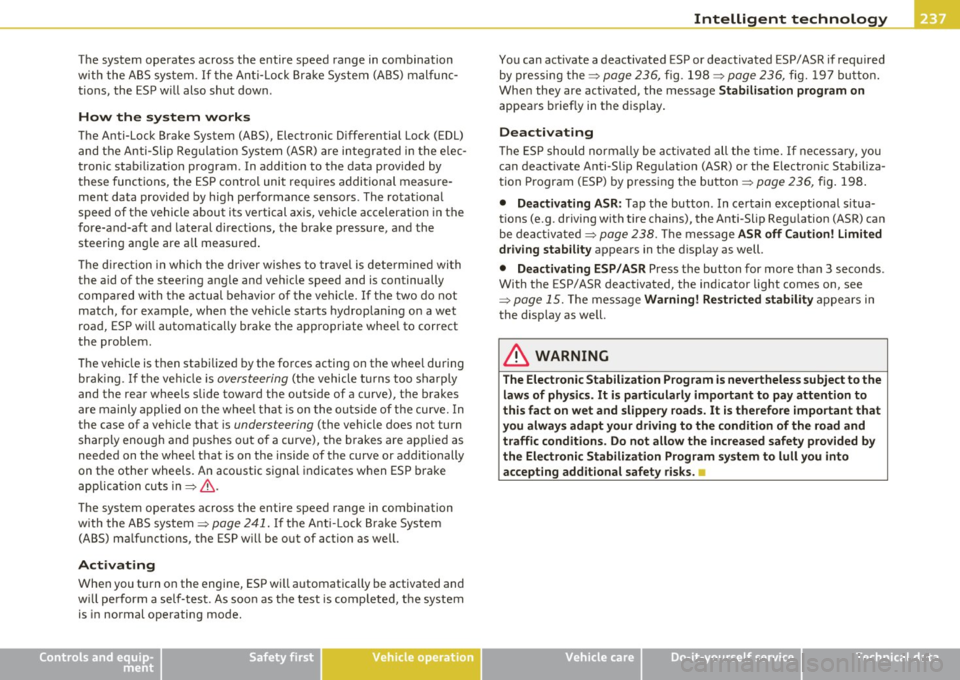
Intelligent technology
--------------------------------------------------' "---.L==--
The system operates across the entire speed range in combination
w ith the ABS sys tem. If the A nti-L o ck Brak e System (A BS) mal fun c
tions, the ESP will also shut down.
How the system works
The Anti-Lock Brake System (ABS), Elect ronic D ifferential Lock (EDL)
and the Anti-Slip Regul ation System (AS R) are in teg rated in the e lec
tronic stab ilizat ion program . In addition to the data prov ided by
th ese fun ctions, the ESP control unit re quires addi tional meas ure
ment data provided by hig h pe rformance senso rs . The ro tat ional
speed of the vehicle about its vertical axis, veh icle acceleration in the
fore-and-a ft and lateral d irect ions, the brake pressure , a nd the
steerin g ang le are all measured .
Th e d irec tion in whi ch the driver w ishes to tra ve l is d ete rm ined wi th
the a id of the steering a ngle and ve hicle speed and is con tinually
c omp ared wi th the a ctu al b ehavior o f the ve hicl e. If t he two do no t
match, for example, when the vehicle starts hydroplani ng on a wet
roa d, E SP w ill automatica lly bra ke the approp riate whee l to correct
the problem.
Th e ve hicle is t hen stab ilized by the fo rces acting on the whee l during
bra king .
If the ve hicl e is oversteering (the vehicle tu rns too s harp ly
and the rear whee ls slide toward the outside of a curve), the brakes
a re mainly a pplied on the whee l tha t is o n the o uts ide of t he curve. In
the case of a vehicle that is
understeering (the vehicle does not turn
shar ply enough and push es out o f a curve), the b rakes are ap plied as
needed on the whee l th at is on the inside of the curve or additionally
on the ot her wheels . An acoustic s ignal indicates w hen ESP bra ke
applica tion cuts in=> &.
T he system operates across the entire speed range in combination
w ith the A BS system =>
page 241. If the A nti-Lo ck Br ake Sys tem
(ABS) ma lfunctions, the ESP w ill be o ut of act ion as we ll.
Activating
When you turn on the engine, ESP wi ll automatica lly be activated and
w ill pe rfor m a self- tes t. As soo n as t he tes t is co mplete d, th e sys tem
is in normal operating mo de.
Controls and equip
ment Safety first Vehicle operation
Yo
u can activate a deactivated ESP or deactivated ESP/ ASR if required
b y pressi ng the =>
page 236, fi g. 1 9 8 => page 236, fig . 19 7 bu tton.
Wh en they are activated, the message
Stabilisation program on
appears briefly in t he di sp lay .
Deactivating
The ES P shoul d no rma lly be acti va te d a ll the tim e. I f necess ary, y ou
can deact ivate A nti-Slip Reg ulat io n (ASR) or th e Electro nic Sta biliza
t ion Progr am ( ES P) by p ress ing the button =>
page 23 6, fig. 198.
• Deactivating ASR: Tap th e button . In cer tain exceptional s itua
t ions (e.g. driving with tire chains), the Anti -Slip Reg ulation (ASR) can
be dea ct iva te d =>
page 238. The m ess age ASR off Caution! Limited
driving stability
a pp ears in the d isp lay as well.
• Deactivating ESP/ASR Press the but ton for mor e tha n 3 seconds .
With the ESP/ ASR deactivated, the indicator light comes on, see
=>
p age 15. The m ess age Warning! Restri cted stability ap pears in
the display as we ll.
& WARNING
The Electronic Stabilization Program is nevertheless subje ct to the
laws of physics . It is particularly important to pay attention to
this fact on wet and slippery roads. It is therefore important that
you always adapt your driving to the condition of the road and
traffic conditions . Do not allow the increased safety provided by
the Electronic Stabilization Program system to lull you into accepting additional safety risks .
u
Vehicle care Do-it-yourself service Technical data
Page 242 of 362
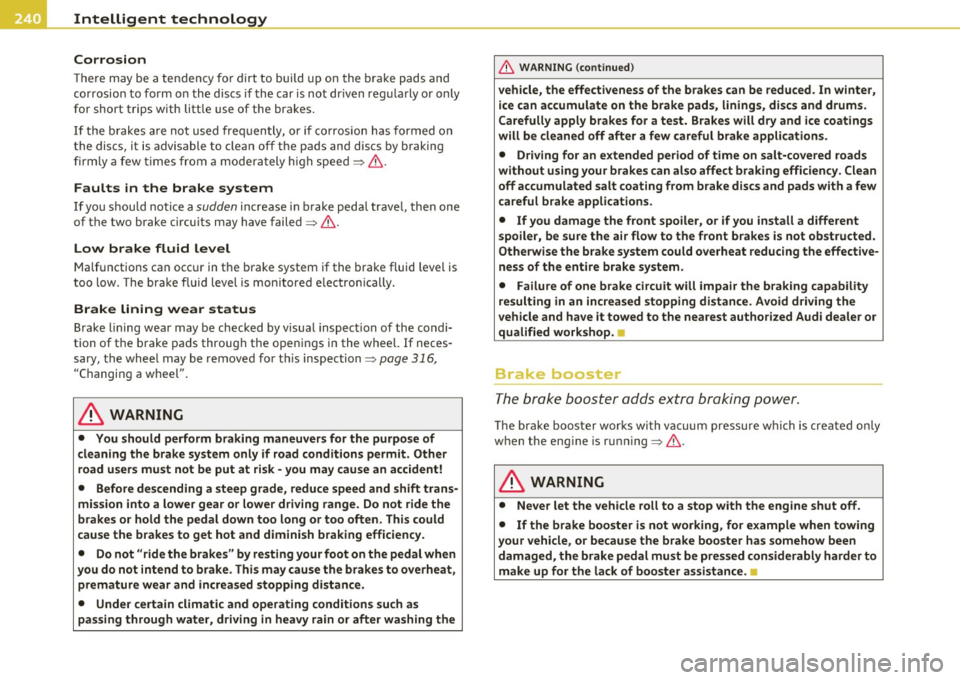
Intelligent technology
'-------------------------------------------------
Corrosion
T he re may be a te ndency fo r d irt to build u p on the bra ke pads and
co rrosion to form on the d iscs if the car is not dr iven reg ularly o r only
for short trips with litt le use of the bra kes .
If the brakes a re not used freq uen tly, or if co rrosion has formed o n
the discs, it is advisable to clean off the pads and discs by braking
fir mly a few times from a mode rat ely h igh spee d~ & .
Faults in the brake system
If yo u sh ou ld noti ce a sudden increase in b rake peda l trave l, then one
of the two brake circu its may have failed~& .
Low brake fluid level
Ma lfunctions can occ ur in t he brake system if the brake fluid level is
t oo low. The bra ke f lu id level is moni tore d elec tron ically.
Brake lin ing wear status
Brake lin ing wear may be checked by v isua l inspect ion of the condi
tion of the brake pads throu gh the open ings in the whee l.
If neces
sary, the whe el may be removed fo r thi s insp ection~
page 3 16,
"Changing a w hee l".
& WARNING
• You should perform braking maneuvers for the purpose of
cleaning the brake system only if road conditions permit. Other
road users must not be put at risk - you may cau se an accident!
• Before descending a steep grade, reduce speed and shift trans
mission into a lower gear or lower driving range. Do not ride the
brakes or hold the pedal down too long or too often . This could
cause the brakes to get hot and diminish braking efficiency.
• Do not "ride the brakes " by resting your foot on the pedal when
you do not intend to brake . This may cause the brakes to overheat ,
premature wear and increased stopping distance.
• Under certain climatic and operating condition s such as
passing through water , driving in heavy rain or after washing the
& WARNING (co ntinued )
vehicle, the effectiveness of the brakes can be reduced . In winter,
ice can ac cumulate on the brake pads, linings, dis cs and drums.
Carefully apply brakes for a test. Brakes will dry and ice coatings
will be cleaned off after a few careful brake appli cations.
• Driving for an extended period of time on salt-covered roads
without u sing your brakes can also affect braking efficiency . Clean
off accumulated salt coating from b rake discs and pads with a few
careful brake applic ations.
• If you damage the front spoiler, or if you install a different
spoiler, be sure the air flow to the front brakes i s not obstructed .
Otherwise the brake system could overheat reducing the effective
ness of the entire brake system.
• Failure of one brake circuit will impair the braking capability
resulting in an increased stopping di stance. Avoid driving the
vehicle and have it towed to the nearest authorized Audi dealer or
qualified workshop.
n
Brake booster
The b roke boost er odds extra broking po wer.
The bra ke boos ter wor ks wi th v acuum pressure whi ch is crea ted o nly
when the eng ine is ru nning~ &.
& WARNING
• Never let the vehicle roll to a stop with the engine shut off.
• If the brake booster is not working, for example when towing
your vehicle , or because the brake booster has somehow been
damaged, the brake pedal mu st be pressed considerably harder to
make up for the lack of booster assistance. •
Page 244 of 362

Intelligent t echnology L ______________________________________ _
Servotronic® - advanced power
steering system
The power steering systems uses the power of the
running engine to allow precise steering with little effort .
The advanced Servotronic® power steering system senses the road
speed and ele ct ronically adjusts power assistance to provide
comfortable and safe steering response exactly matched to the
veh icle speed .
Power steering will not work if the engine is off . As a resu lt, the
steeri ng wheel will be hard to turn.
T he power steeri ng fluid level is checked du ring the sched uled main
tenance services .
0 Note
If there is an electronic malfunction, servotronic will still function
like a conventional power s teer ing system, provid ing a cons tant
steering support force that is no longer proportionate to the vehicle
speed. This is most noticeable when t urning the s teer ing wheel at low
speeds (for example when park ing) , - more effor t will be required
than us ua l.
• Be aware of the d ifferent than usual steering response and adjust
your stee ring force accord ingly .
• Have the prob lem checked and set r ight by an Audi dealer as soon
as possib le.
[ i ] Tips
• When the e ngine is running, neve r hold the stee ring whee l turned
all the way to the rig ht or to the left for longer than 15 seconds. The
powe r steering pump wi ll overheat the hydra ulic fluid if yo u keep
holding the steering wheel turned all the way . This is likely to damage
t he power s teer ing system . •
If the power steering system s hou ld fa il entirely, or if the engine
is no t ru nning (fo r examp le, while be ing towed), you will st ill be able
to steer the vehicle. However,
considerably more effort will be
req uired to do so .
• If the power steering system should have a leak, or is not func
tioning prope rly, con tact your au thor ized A udi dealer immedia tely.
• The power steer ing system requires a specia lly formulated
hyd raulic fluid. The power steer ing rese rvoir is the one loc ated
farthest to the rear on the left s ide of the eng ine compartme nt
=>
page 2 76 . T he correct fluid leve l in the reservo ir is im port an t fo r
proper functioning of the power steeri ng .•
Dr"ving with your quattro®
With all wheel drive, all four wheels ore driven.
General information
With all wheel d rive, power is d istributed to all four wheels. This
h appens a utomatically depending on your dr iv ing style and t he road
conditions at the time . See also =>
page 238, "Electronic different ial
loc k (ED L)".
T he all whee l dr ive concept is designed for high engine power . Your
veh icle is except ionally powe rf ul and has excellent driving character
istics both under normal driving condit ions and on snow and ice .
Always read an d fo llow safety precautions =>& .
Winter tires
When driving in the winter, your vehicle with a ll whee l drive has an
adva ntage, even w ith regular t ires . In winter road cond it io ns it may
be advisable to mount winte r tires (or all-seaso n tires) for improved
dr iveability a nd b rak ing: t hese tires mus t be mounted on
all four
wheels . See also => page 307, "Winter ti res" .
Tire chains
Where tire chains are mandatory on certa in roa ds, this norma lly a lso
applies to veh icles with a ll w heel drive =>
page 308, "Snow chains" . Iii-
Page 249 of 362

____________________________________________ D_ r_ i_ v _i_,ng and environment
New brake pads have to be "b urn ished in" before they have opt imal
grab ~& -
Dur ing the break-in period, you sho uld avoid putti ng severe loads on
the brakes. Severe loads include, for example, sud den ha rd brak ing,
i n part icula r a t very high s peed s or, for e xam ple, on moun tain passes.
& WARNING
New brake pads don't have the best stopping power and must be
" broken-in " during the initial 100 to 150 miles (150 to 200 kilo
meters ) of normal city driving . You can compensate for this by
p ressing the brake pedal more firmly . This also applies later when
new pad s are installed .•
Avoid damaging the vehicle
Whe n yo u are d riving on poor ro ad s, or ove r curbs, steep r amps, etc.,
ma ke ce rtain that low -lying parts such as spoilers and exhaust system
p arts do not bo ttom out and ge t damage d.
Th is is espec ia lly true for veh icles with low-slung chass is (sports
chassis)* and fully loaded vehicles .
a
Driving through water on roads
Note the fo llowing to avoid vehicle damage w hen drivi ng thro ugh
water, fo r examp le on flooded roa ds:
• The wate r must not be any h igher than the bottom of the vehicle
b ody .
• Do not dr ive faster tha n walk ing spee d.
Controls and equip
ment Safety first Vehicle operation
& WARNING
After driving through water, mud
, slush, etc ., the brakes may be
slow to take effect because of wet brake rotors and pads. Dry the
brakes first by braking carefully to restore the full braking effect .
0 Note
Vehicle components such as the engin e, tra nsmission, sus pension or
elect rical system can be severe ly damaged by driv in g thro ugh water .
[ i ] Tips
• Check the depth of t he wate r before driving throug h it.
• Do not stop the vehicle, drive in reverse or switch the e ng ine off
w hen driving throug h wate r.
• Keep in m ind that o ncoming vehicles may c reate waves that raise
t he water leve l and make it too deep fo r yo ur vehicle to d rive throug h
safely.
• Avo id drivi ng t hroug h sa lt w at er bec ause it can cause cor rosio n.
Catalytic converter
It is very imp ortant that your emission contr ol syst em
(ca ta lytic convert er) is functioning pro p erly to ensur e
t h at your vehic le is runnin g in an environment ally s oun d
man ner .
- Always use lead -f re e gasoli ne~ p age 269 , "Fuel sup ply" .
- Never r un th e t ank down a ll the way to em pt y.
- Neve r pu t too muc h mo to r oil i n y our eng ine ~
page 279,
"Add ing eng ine oil
'l!:r." .
- Never try to p ush- or tow-start your veh icle.
Vehicle care Do-it-yourself service Technical data
Page 253 of 362
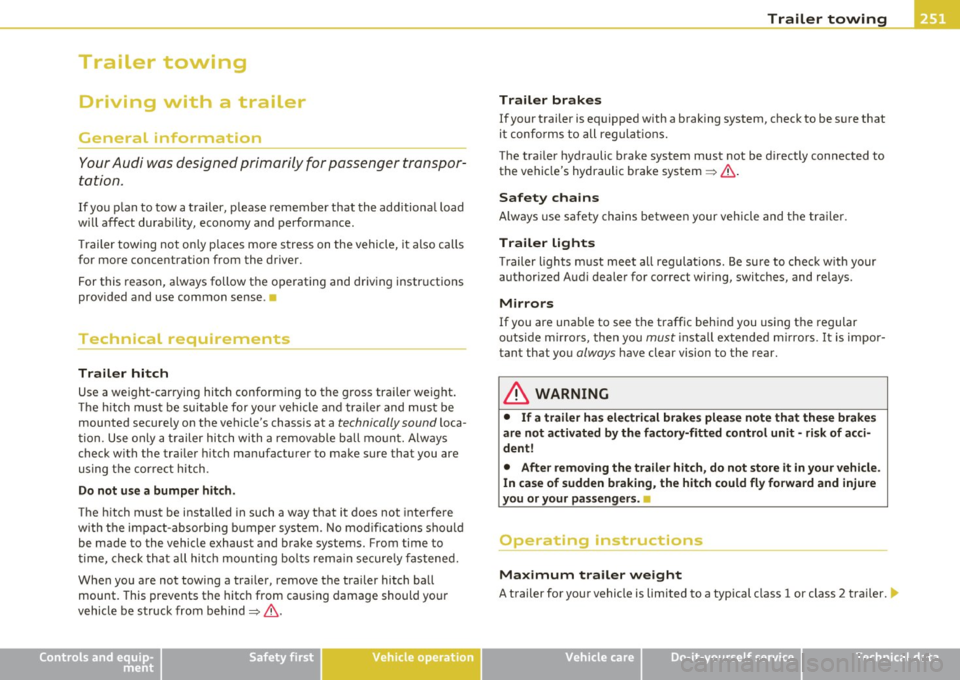
Trailer towing
Driving with a trailer
General information
Your Audi was designed primarily for passenger transpor
tation.
If yo u plan to tow a t rai ler, p lease rem emb er that the add itiona l load
wi ll affect durab ility, economy and performance.
T railer tow ing not on ly p laces mo re s tress on the vehicle, it a lso calls
for more concentrat ion from the driver.
For this reason, a lways follow the ope rating and dr iv ing instr uctions
prov ided and use common sense .
Technical requirements
Trailer hitch
Use a weight-carrying hitch conforming to the gross trailer weig ht.
Th e hitch mus t be suitable for yo ur vehicle a nd tra ile r and mus t be
mounted secure ly on the vehicle's chassis at a
technically sound l oca
t ion. Use only a trailer hitch wi th a remov ab le b all m ount. Alw ays
check w ith the tra iler hitch manufacturer to make sure that you are
using t he cor re ct hi tch.
Do not use a bumper hitch.
The h itch must be installed in such a way t hat it does not interfere
w ith the impa ct-absorbing b umper system. No mod ifi cat ions sho uld
be made to the vehicle exhaust and brake systems. From time to
ti me, chec k tha t all hitc h mou ntin g bol ts rem ain secure ly f aste n ed.
When you a re not tow ing a tra iler, remove the tra iler hitch ba ll
mount. This prevents the hitc h from caus ing damage should yo ur
vehicle be struck from behind=> &.
Controls and equip
ment Safety first Vehicle operation
Trailer brakes
If your trailer is eq
uipped with a braking system, check to be s ure that
i t confo rm s to all regula tions.
The tra iler hydraulic brake system must not be directly connected to
the vehicle's hydraulic brake system=>& .
Safety chains
Alw ays use safety chains be twee n your vehicle and the trai ler.
Trailer lights
Tr ailer l ights m ust meet all reg ulat io ns. Be su re to check with your
author ized Audi deale r for correct wir ing, switches, and re lays.
Mirrors
If you are unab le to see the traffic behind you us ing the regular
outside m irro rs, then you
must install extended m irro rs. It is impor
tant that yo u
always have clear vision to the rear.
& WARNING
• If a trailer has electrical b rake s please note that these brakes
are not activated by the factory-fitted control unit -ri sk of acci
dent!
• After removing the trailer hitch , do not store it in your vehicle.
In case of sudden braking, the hitch could fly fo rward and injure
you or your passengers. •
Operating instructions
Maximum trailer we ight
A trailer for your vehicle is limited to a typical class 1 or class 2 trailer . .,.
Vehicle care Do-it-yourself service Technical data
Page 254 of 362
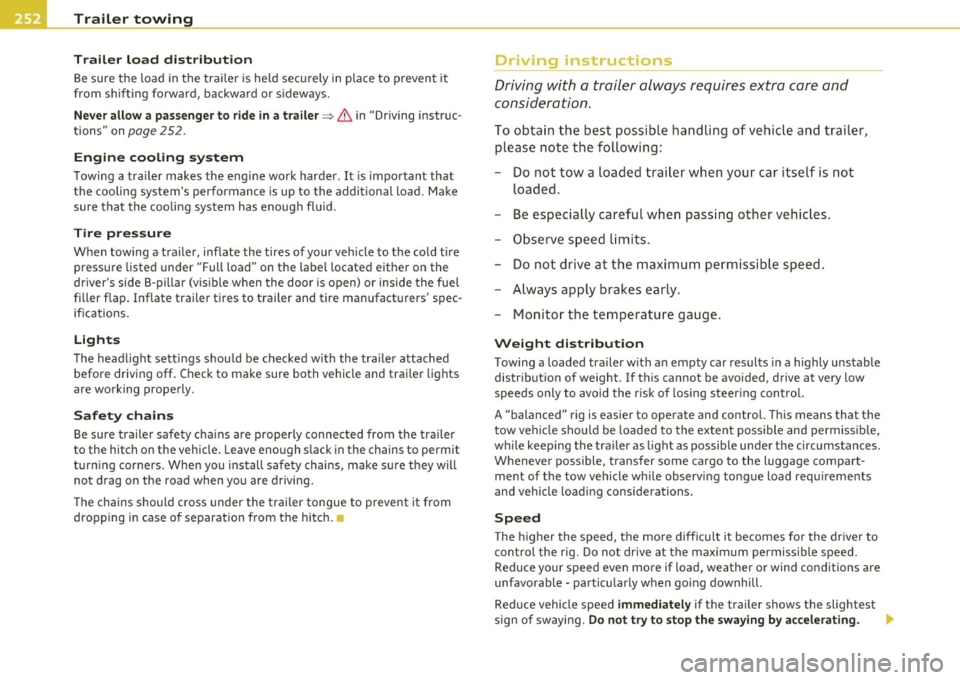
Trailer towing
"-------------------------------------------------
Trailer load distribution
Be sure the load in the trailer is held securely in pla ce to prevent it
from shifting forward, backward or s ideways.
Never allow a passenger to ride in a trailer => & in "Driving instruc
tions" on
page 252.
Engine cooling system
Towing a trailer makes the eng ine work harde r. It is important that
the cooling system's performance is up to the additional load. Make
sure that the cooling system has enough fluid.
Tire pressure
When towing a trailer, inflate the tires of your vehicle to the cold tire
pressure listed under "Full load" on the label located either on the
dr iver's side B-pillar (visible when the door is open) or inside the fuel
filler flap . Inflate trailer tires to trailer and tire manufacturers' spec
ifications.
Lights
The headl ight settings should be checked w ith the trailer attached
before driving off. Check to make sure both vehicle and trai ler lights
are working properly.
Safety chains
Be sure trailer safety cha ins are properly connected from the trailer
to the hitch on the vehicle. Leave enough s lack in the chains to permit
turning corners. When you install safety chains, make sure they will
not drag on the road when you are driving.
T he chains should cross under the trailer tongue to p revent it from
dropping in case of separation from the hitch.
Driving instruct!ons
Driving with a trailer always requires extra care and
consideration.
To obtain the best possible handling of vehicle and trailer,
please note the following:
- Do not tow a loaded trailer when your car itself is not
loaded.
- Be especially careful when passing other veh icles .
- Observe speed limits.
- Do not drive at the maximum permissible speed.
- Always apply brakes early.
- Monitor the temperature gauge .
Weight distribution
Towing a loaded trailer w ith an empty car results in a highly unstable
distr ibution of weight. If this cannot be avoided, drive at very low
speeds only to avo id the r isk of losing steer ing control.
A "balanced" rig is easier to operate and control. Th is means that the
tow vehicle should be loaded to the extent possible and permissible,
wh ile keeping the trailer as light as possible under the c ircumstances.
Whenever possible, trans fer some cargo to the luggage compart
ment of the tow vehicle while observing tongue load requirements
and vehicle loading considerations.
Speed
Th e higher the speed, the more difficult it becomes for the driver to
control the r ig . Do not drive at the maximum permiss ible speed.
Reduce your speed even more if load, weather or wind conditions are
unfavorable -part icularly when go ing downhill.
Reduce vehicle speed
immediately i f the trailer shows the slightest
sign of swaying.
Do not try to stop the swaying by accelerating. _,
Page 255 of 362

Observe speed limits. In some areas, speeds for vehicles towing
t railers are lowe r than for regular veh icles.
Always apply brakes early. When dr iv ing downh ill, sh ift in to a lower
gear to use the engine braking effect to slow the vehicle. Use of the
brakes alone can cause them to overheat and fail.
Coolant temperature
The coolant temperature gauge~ page 10 must be observed care
fully. If the needle moves close to the upper end of the scale, reduce
speed immediately and/or turn off the air conditione r.
If the coolant temperature warning light in the instrument cluster
star ts flashing
-t- , pull off the road, stop and let the engine idle for
about two minutes to prevent heat bu ild-up.
& WARNING
Anyone not properly restrained in a moving vehicle is at a much
greater risk in an accident. Never let anyone ride in your car who is
not properly wearing the restraints provided by Audi. u
Trailer towing tips
Important to know
------------
Your vehicle handles differently when tow ing a tra iler because of the
additiona l weight and different weight distribution. Safety, perfor
mance and economy will greatly depend on how carefu lly you load
your trailer and operate your rig .
Before you actua lly tow your trailer, practice turning, stopp ing and
backing up in an area away from traffic. Keep pract icing until you have
become completely familiar with the way your vehicle-t railer combi
nation behaves and responds.
Controls and equip ment Safety first Vehicle operation
Backing up
is d iff icult and requ ires practice . Backing up with a trailer
generally requires steer ing action opposite to that when backing up
your vehicle without a trailer.
Maintain a greater distance between your vehicle and the one in front
of you. You will need more room to stop . To compensate fo r the
trailer, you will need a larger than norma l turning radius.
When passing, remember that you cannot accelerate as fast as you
normally would because of the added load. Make sure you have
enough room to pass. After passing, allow plenty of room for you r
trailer before changing lanes again.
Avoid jerky starts, sharp turns or rapid lane changes .
[I) Tips
• Do not tow a trai ler during the break-in per iod of your vehicle.
• If you tow a tra iler, your Audi may requi re more frequent mainte
nance due to the extra toad~
page 340. •
Parking on a slope
Do not park on a slope with a trailer. If it cannot be
avoided, do so only after doing the following:
When parking:
-Apply the foot brake.
- Have someone place chocks under both the vehicle and the
trailer wheels.
- With chocks in place, slowly release the brakes until the
wheel chocks absorb the load.
- Turn the wheels towards the curb.
- Apply the parking brake .
Vehicle care Do-it-yourself service Technical data
Page 256 of 362

Trailer towing
"-------------------------------------------------
- Place an automatic transmission* in P, respectively a
manual transmission in first or reverse gear.
When restarting after parking:
- Apply the foot brake.
- Start the engine.
- Move the selector lever to
D, respectively a manual trans-
mission in first gear.
- Release the parking brake and slowly pull out and away
from the wheel chocks.
- Stop and have someone retrieve the wheel chocks.
00 Tips
If you move the selector lever of the automatic transmission* to P
before applying the parking brake and before blocking the wheels,
you may have to use more force later to move the lever out of the P
position. •
Page 262 of 362
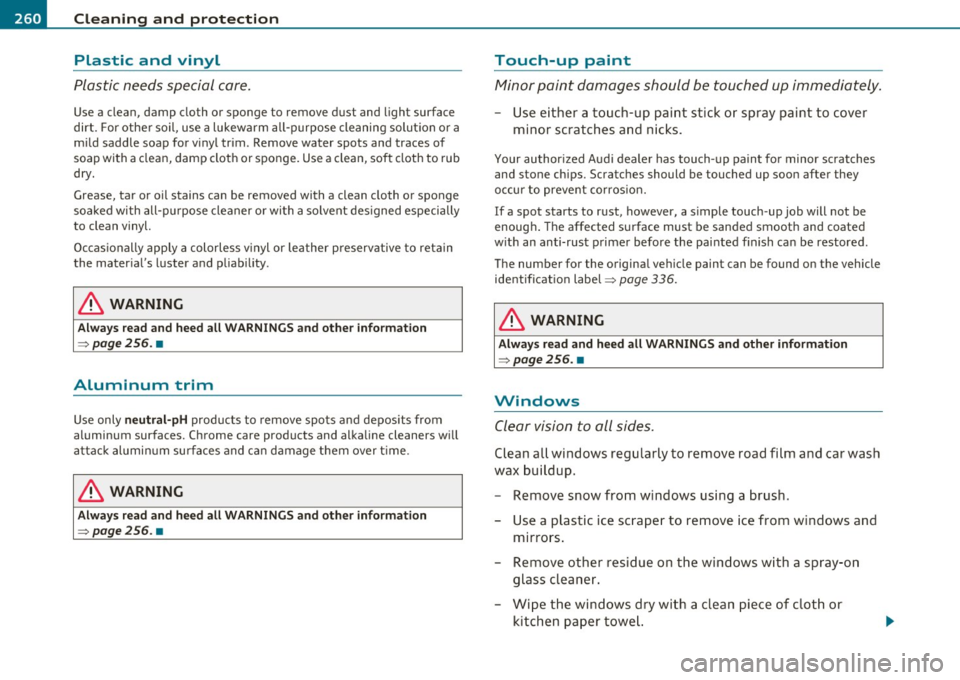
-~_C_ le_ a_n_ i_ n_ g=- a_ n_d__. p_ ro_ t_e _c_ t_ i_o _n ___________________________________________ _
Plastic and vinyl
Plastic needs special care.
Use a clean, damp cloth or sponge to remove dust and light surface
dirt. For other soil, use a lukewarm all-purpose cleaning solution or a
mild saddle soap for vinyl trim . Remove water spots and traces of
soap with a clean, damp cloth or sponge. Use a clean, soft cloth to rub
dry.
Grease, tar or oil stains can be removed with a clean cloth or sponge
soaked with all-purpose cleaner or with a solvent designed especially
to clean vinyl.
Occasionally apply a colorless vinyl or leather preservative to retain
the material's luster and pliability.
& WARNING
Always read and heed all WARNINGS and other information
:::> page 256. •
Aluminum trim
Use only neutral-pH products to remove spots and deposits from
aluminum surfaces. Chrome care products and alkaline cleaners will
attack aluminum surfaces and can damage them over time .
& WARNING
Always read and heed all WARNINGS and other information
=>page 256. •
Touch-up paint
Minor paint damages should be touched up immediately.
- Use either a touch-up paint stick or spray paint to cover
minor scratches and nicks.
Your authorized Audi dealer has touch-up paint for minor scratches
and stone chips. Scratches should be touched up soon after they
occur to prevent corrosion.
If a spot starts to rust, however, a simple touch-up job will not be
enough. The affected surface must be sanded smooth and coated
with an anti-rust primer before the painted finish can be restored.
The number for the original vehicle paint can be found on the vehicle identification label=>
page 336.
& WARNING
Always read and heed all WARNINGS and other information
=>page 256. •
Windows
Clear vision to all sides.
Clean all windows regularly to remove road film and car wash
wax buildup.
- Remove snow from windows using a brush.
- Use a plastic ice scraper to remove ice from windows and
mirrors.
- Remove other residue on the windows with a spray-on glass cleaner.
- Wipe the windows dry with a clean piece of cloth or
kitchen paper towel.
Page 268 of 362
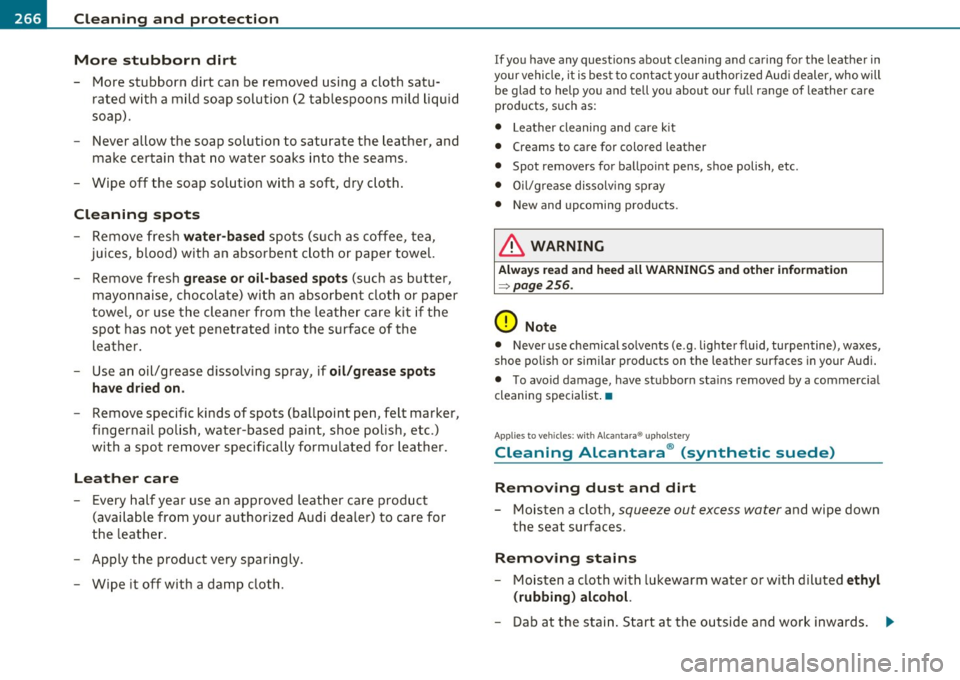
-~_C_ le_ a_n_ i_ n_ g=- a_ n_d___. p_ ro_ t_e _c_ t_ i_o _n ___________________________________________ _
More stubborn dirt
- More stubborn dirt can be removed using a cloth sa tu
rated w ith a mild soap solution (2 tablespoons mild liquid
soap).
- Never allow the soap solution to saturate the leather, and
make certain that no water soaks into the seams .
- Wipe off the soap solution with a soft, dry cloth .
Cleaning spots
- Remove fresh water -ba sed spots (such as coffee, tea,
juices, blood) with an absorbent cloth or paper towel.
- Remove fresh
g rease or oil-based spots (such as butter,
mayonnaise, chocolate) with an absorbent cloth or paper
towel, or use the cleaner from the leather care ki t if the
spot has not yet penetrated into the surface of the
leather.
- Use an oil/grease dissolving spray, if
oil /grease spots
have dried on .
-Remove specific kinds of spots (bal lpoint pen, felt marker ,
fingernail polish, water-based paint, shoe polish, etc.)
with a spot remover specifically formulated for leather.
Leather care
- Every half year use an approved leather care produc t
(available from your authorized Audi dealer) to care for
the leather .
- Apply the product very sparingly.
Wipe it off with a damp cloth.
If you have any questions about cleaning and caring for the leather in
your vehicle, it is best to contact your au thor ized Aud i dealer, who will
be glad to help you and tell you about our full range of leather care
products, such as:
• Leather cleaning and care k it
• Creams to care for colored leather
• Spot removers for ballpoint pens, shoe polish, etc .
• Oil/grease dissolv ing sp ray
• New and upcoming products.
& WARNING
Alw ays re ad and heed all WARNINGS and other information
=> page 2 56 .
0 Note
• Never use chemical so lve nts (e.g . lighter fluid, turpentine), waxes,
shoe po lish or simi lar products on the leather surfaces in your Audi .
• T o avo id damage, have stubborn sta ins removed by a commerc ial
cleaning specialist .•
Ap plies to veh icl es: w it h Alc anta ra ® u pholst ery
Cleaning Alcantara ® (synthetic suede)
Removing dust and dirt
- Moisten a cloth, squeeze out excess water and wipe down
the seat surfaces.
Removing stains
- Moi sten a cloth with lu kewarm water or with diluted ethyl
( rubb ing ) al cohol.
- Dab at t he stain . Start at the ou tside and work inwards. .,